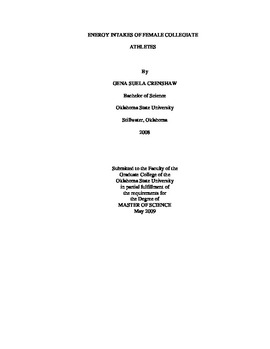| dc.contributor.advisor | Shriver, Lenka Humenikova | |
| dc.contributor.author | Crenshaw, Gena Suela | |
| dc.date.accessioned | 2014-04-15T22:01:01Z | |
| dc.date.available | 2014-04-15T22:01:01Z | |
| dc.date.issued | 2009-05-01 | |
| dc.identifier.uri | https://hdl.handle.net/11244/9217 | |
| dc.description.abstract | The main purpose of this study was to evaluate energy intakes in a sample of female collegiate athletes and compare their reported energy intakes to the total daily energy needs. The second purpose of the study was to determine whether differences between RMR measured by indirect calorimetry and RMR estimated by the Harris – Benedict and Cunningham equations exist in the target population. The third purpose of the study was to explore the relationship between energy intake and body composition, including lean body mass and fat mass in the target population. Finally, the relationship between athletes' reported energy intake and eating attitudes was explored. This exploratory study used a convenience sample of collegiate athletes and 45 female athletes were recruited from several teams including soccer (n=18), cross – country and/or track and field (n=16), and basketball (n=11). Athletes were assessed for body composition using a Hologic DEXA scanner. RMR for each athlete was measured using indirect calorimetry (Vmax Encore metabolic cart, Viasys) as well as estimated by the Harris-Benedict and Cunningham equations. Each athlete completed a 24 hour recall, 3 – day food record, and eating attitude test. Measured RMR was compared to estimated RMR. Recommended energy intake based on measured RMR was compared to reported energy intake from a 4 – day energy intake average. Findings and Conclusions: The results of this study indicated that subjects' consumed a significantly lower amount of energy compared to their daily energy recommendations. Only six out of 29 subjects who completed the dietary and metabolic measurements met their total daily energy needs. The Harris – Benedict and Cunningham equations were not reliable tools for estimating RMR within this athletic population, with both estimating RMR to be significantly higher than the RMR measured using indirect calorimetry. There was no significant difference in body composition between athletes who reported consuming the recommended amount of energy and those who failed to meet their total daily energy requirements. | |
| dc.format | application/pdf | |
| dc.language | en_US | |
| dc.publisher | Oklahoma State University | |
| dc.rights | Copyright is held by the author who has granted the Oklahoma State University Library the non-exclusive right to share this material in its institutional repository. Contact Digital Library Services at lib-dls@okstate.edu or 405-744-9161 for the permission policy on the use, reproduction or distribution of this material. | |
| dc.title | Energy Intakes of Female Collegiate Athletes | |
| dc.type | text | |
| dc.contributor.committeeMember | Betts, Nancy M. | |
| dc.contributor.committeeMember | Smith, Doug | |
| osu.filename | Crenshaw_okstate_0664M_10297.pdf | |
| osu.college | Human Environmental Sciences | |
| osu.accesstype | Open Access | |
| dc.description.department | Department of Nutritional Sciences | |
| dc.type.genre | Thesis | |
